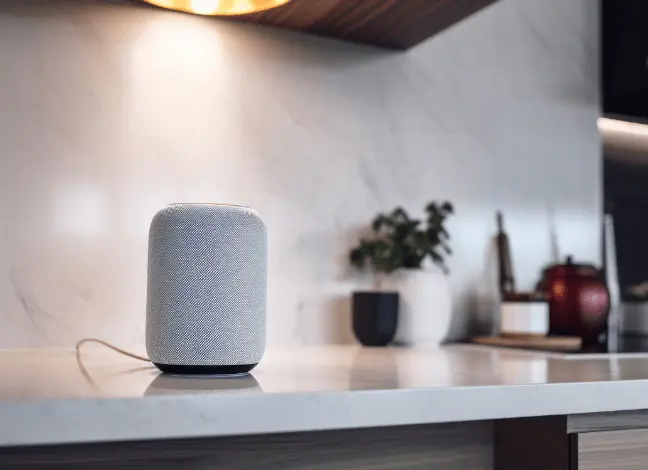Smart speakers have built-in intelligent virtual assistants to listen to your commands and respond using artificial intelligence.
What is a Smart Speaker?
Smart speakers are speakers with built-in intelligent virtual assistants. These smart speakers have built-in microphones to listen to your commands and respond using artificial intelligence.

Users can communicate with the smart speaker by giving voice commands, such as asking questions or commanding them to do a task, such as playing music, adding items to shopping lists and setting reminders and alarms.
Amazon’s smart speakers are a prime example with a built-in virtual assistant called “Alexa”, which generally responds to questions like “What is the temperature outside now?” or “What are the best-selling earbuds?” for which it searches the internet to find the answer and reads them out.
How does a smart speaker work?
Smart speakers use hardware and software components to process voice commands, connect to the internet, and interact with various smart devices.
Here’s a breakdown of how they generally function:
Microphones – Smart speakers use built-in microphones to listen to noise from their surroundings constantly. Most modern smart speakers have more than one microphone to increase the ability to catch anything you say. For example, the Amazon Alexa Echo Dot has six microphones. They also rely on activation phrases such as “Alexa,” “Hey Google,” or “Hey Siri”, which, when they detect, begin recording the user’s voice command.

Speech Recognition – The recorded voice command is processed by the speaker’s speech recognition software, which converts the spoken words into text using sophisticated algorithms. This text data is then analysed using clever algorithms to understand the user’s intent and extract the meaning behind the command.
Connection to cloud – The interpreted command is sent over the internet to cloud-based servers. These servers process the request, access vast information databases, and perform the requested tasks.
Task execution – The smart speaker’s cloud-based service performs the necessary actions based on the interpreted command. This could involve retrieving information like weather updates or news, controlling smart home devices, setting reminders, playing music, making purchases, and more.
Feedback and Response – Once the action is completed, the smart speaker may respond verbally or perform the requested task, such as turning off lights, playing a specific song, or providing the requested information.
Integration with smart home devices – Smart speakers communicate with various smart devices, lights, thermostats and cameras using compatible protocols like Wi-Fi, Bluetooth, Zigbee, or Z-Wave. They act as a central hub to send commands to these devices, enabling users to control their smart homes via voice commands.
The continuous advancements in artificial intelligence, machine learning, and improvements in hardware components contribute to the enhanced capabilities and responsiveness of smart home speakers.
Functions of smart speakers
Smart speakers, like Amazon Echo, Google Home, or Apple HomePod, offer a range of functions.
| Voice assistant: | They have built-in voice assistants like Alexa, Google Assistant, or Siri that can perform tasks based on voice commands. |
| Information retrieval: | They can provide information on weather forecasts, news updates, sports scores, general knowledge queries, and more by accessing online databases. |
| Smart Home Control | Integration with smart home devices lets users control lights, thermostats, locks, cameras, and other compatible intelligent appliances through voice commands. |
| Music Streaming | They can play music from streaming services like Spotify, Apple Music, or Amazon Music based on user requests. |
| Alarm & Timers | Smart speakers can set alarms, reminders, and timers as a personal assistant for scheduling activities. |
| Voice Calls & Messaging | Some models allow users to make hands-free calls, send messages, or even make video calls using compatible services. |
| Shopping & To-Do Lists | Users can create shopping and to-do lists and order products from online retailers using voice commands. |
| Entertainment & Games | They offer various entertainment options, like playing games, telling jokes, narrating stories, and providing interactive experiences. |
| Cooking Assistance | Smart speakers can offer recipe suggestions, cooking timers, and measurement conversions, aiding the kitchen. |
| Personalisation: | They can learn user preferences over time, providing personalised recommendations for music, news, and other content. |
| Educational Assistance | Some smart speakers offer educational content, quizzes, language learning tools, and general knowledge enhancement. |
Smart speakers, Bluetooth speakers & Wi-Fi speakers:
What is the difference between Smart speakers, Bluetooth speakers & Wi-Fi speakers?
Although they are all speakers, Smart, Bluetooth, and Wi-Fi speakers serve different purposes and have distinct functionalities.
Smart speakers are multifunctional devices with voice assistants and various innovative capabilities beyond just playing music. In contrast, Bluetooth and Wi-Fi speakers focus primarily on wireless audio playback but have different connectivity and functionality features.
Smart Speakers
Smart speakers have voice assistants such as Amazon Alexa, Google Assistant, or Apple Siri, which are designed to play music, respond to voice commands, and perform various tasks.
They typically connect to the internet via Wi-Fi and have multiple microphones to listen for wake words and process voice commands. They can control smart home devices, provide information, set reminders, play music, and perform various tasks beyond audio playback.
Top Smart Speaker
Amazon Echo – The Echo line offers a range of options with different sizes, capabilities, and price points, all featuring Alexa as the voice assistant.
Google Nest Audio/Google Home – These speakers integrate Google Assistant, providing various smart features and good sound quality.
Apple HomePod mini – Designed for Apple users, it features Siri integration, offering good sound quality and smart home control within the Apple ecosystem.
Sonos One – Integrating both Alexa and Google Assistant, the Sonos One offers excellent sound quality and supports multi-room audio.
Bose Home Speaker 500 – Known for its sound quality, this speaker features both Alexa and Google Assistant, with a sleek design and intelligent capabilities.
Bluetooth Speakers
Bluetooth speakers are designed primarily for wireless audio playback from smartphones, tablets, or computers. They connect to these devices via Bluetooth, allowing users to stream music or audio from their devices without requiring a physical connection.

They don’t usually have voice assistants or the ability to perform tasks beyond audio playback. They rely on a paired device for content and cannot control smart home devices.
Many Bluetooth speakers are portable and battery-powered, making them convenient for on-the-go use.
Top Bluetooth Speakers
JBL Flip 5 – A popular portable Bluetooth speaker known for its durability, sound quality, and long battery life.
UE Boom 3 – Another portable option with 360-degree sound, water resistance, and a durable build.
Sony SRS-XB43 – This speaker offers powerful bass, LED lighting effects, water resistance, and long battery life, making it suitable for outdoor use.
Anker Soundcore Flare – A budget-friendly option with good quality, 360-degree sound, and customisable LED lights.
Bose SoundLink Revolve+ – Known for its excellent sound quality, portability, and 360-degree sound dispersion.
Wi-Fi Speakers
Wi-Fi speakers are also used for wireless audio playback. Still, they connect to the internet through Wi-Fi networks.
They can access music streaming services directly without relying on a connected device. Some Wi-Fi speakers may offer multi-room audio capabilities, allowing synchronisation between multiple speakers in different rooms.
While focusing on high-quality audio playback, some models might integrate voice assistants, enabling limited intelligent functionalities like controlling compatible devices or accessing online services.
Top Wi-Fi Speakers
Sonos Move – A versatile, durable, portable speaker with Wi-Fi and Bluetooth connectivity, delivering high-quality sound and intelligent capabilities.
Bose SoundTouch 20 Series III – Offers excellent sound quality, multiple connectivity options, and integration with various music services.
Denon Home 150 – A compact Wi-Fi speaker with good sound quality, HEOS multi-room audio, and voice assistant support.
Harman Kardon Citation 100 – Stylish design, good sound quality, and Google Assistant integration make it a solid Wi-Fi speaker option.
Yamaha MusicCast 20 – A compact speaker with good sound quality, Wi-Fi connectivity, and support for Yamaha’s MusicCast multi-room system.
Smart speaker and Smart display:
What is the difference between a Smart speaker and a Smart display? The primary difference between a smart speaker and a Smart display lies in their form and functionality:
| Smart Speaker | Smart display |
| A smart speaker is primarily an audio-focused device. It typically resembles a traditional speaker and is designed to produce sound. | An intelligent display integrates a screen and a smart speaker’s functionalities. It resembles a tablet or digital picture frame with an attached speaker. |
| Smart speakers have microphones and built-in voice assistants (like Alexa, Google Assistant, or Siri). They can respond to voice commands, answer questions, play music, control smart home devices, set reminders, and perform various tasks solely through voice interaction. | In addition to the capabilities of a smart speaker, intelligent displays offer a visual interface. They can show information such as weather forecasts, cooking recipes with step-by-step instructions, calendar events, video calls, and visual responses to queries. |
| Smart speakers lack a screen or visual interface, unlike smart displays. They rely entirely on audio feedback for interactions. | Smart displays are handy when visual information complements voice interaction, such as following recipes, viewing weather forecasts, watching videos, or making calls. |
In essence, while smart speakers and smart displays share similar voice assistant capabilities, smart displays add a visual component through an integrated screen, offering a more interactive and visually enhanced user experience than smart speakers.



Pingback: Sensible Audio system | How does good audio system work? - LootleBaba
Pingback: Smart Speakers | How does smart speakers work? - Kowatek